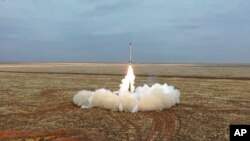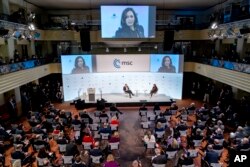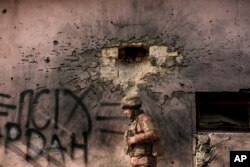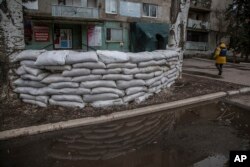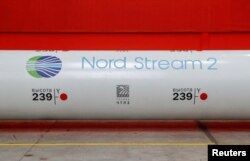Russian President Vladimir Putin presided over massive military drills as shelling escalated in eastern Ukraine Saturday after U.S. President Joe Biden said Putin has made up his mind to invade Ukraine.
“I'm convinced he's made the decision. We have reason to believe that,” Biden said Friday during remarks from the White House.
On Saturday, the Russian military launched massive drills of its strategic nuclear forces that were personally overseen by Putin, although Biden said he did not believe Putin is seriously contemplating the use of nuclear weapons.
Russia’s defense ministry said the exercises, which the Kremlin says were previously planned to check readiness, involved a number of practice submarine launches of intercontinental ballistic missiles, with Putin and the president of Belarus looking on from a “situation center.”
‘Poised to strike’
On Saturday, U.S. Defense Secretary Lloyd Austin said the more than 150,000 Russian troops that have amassed at Ukraine’s border “are now poised to strike,” as he spoke with reporters in Lithuania, where Lithuanian President Gitanas Nauseda called for an increased U.S. troop presence.
At the annual Munich Security Conference Saturday, U.S. Vice President Kamala Harris warned that Russia’s plan was already unfolding.
“There is a playbook of Russian aggression, and this playbook is too familiar to us all. Russia will plead ignorance and innocence. It will create false pretext for invasion, and it will amass troops and fire power in plain sight,” said Harris, who added a Russian invasion would trigger sanctions that include far-reaching financial sanctions and export controls.
Harris also warned the U.S. would bolster NATO’s eastern flank as another deterrent to a Russian military invasion.
Speaking at the conference earlier Saturday, NATO Secretary-General Jens Stoltenberg said that Russia, in threatening Ukraine, “will get more NATO” instead of the lower NATO footprint Putin says he is seeking.
Stoltenberg also said he has sent a letter to Lavrov calling for a meeting of the NATO-Russia Council to avert a conflict in Ukraine. Stoltenberg told the Munich Security Conference that there is no evidence that Russia has withdrawn any of its troops from Ukraine’s borders and there is a real risk of conflict.
"We are extremely concerned because we see that they continue to build up, they continue to prepare. And we have never in Europe seen since the end of the Cold War, such a large concentration of combat-ready troops," Stoltenberg said.
Also attending the security conference Saturday was Ukrainian President Volodymyr Zelenskiy, despite a sharp increase in shelling in eastern Ukraine. Zelenskiy met on the sidelines with Vice President Harris, as he aims to rally more military and financial support from Western allies.
As he addressed the audience of high-level officials and security experts from around the world, Zelenskiy pushed back against U.S. predictions of an imminent Russian invasion, declaring “We do not think we need to panic,” AFP reported.
German Foreign Minister Annalena Baerbock said on the sidelines of the conference, according to AFP, that “We do not know yet if an attack has been decided on,” although she added that the “threat against Ukraine is very real.”
Fresh attacks
Meantime, Ukraine’s military accused rebels of two breakaway territories in eastern Ukraine – the self-proclaimed Donetsk and Luhansk republics – of carrying out a new wave of attacks on Saturday.
The rebels, who also accused Ukraine’s military of carrying out new attacks on Saturday, signed mass military mobilization decrees. The head of one of the territories urged all able-bodied men to take up arms against what he claimed is Kyiv’s aggression. The regions have also begun evacuating some civilians from border areas.
Biden said the move was a result of Russian misinformation, saying that it “defies basic logic” that people in Ukraine would “choose this moment” to engage in combat with more than 150,000 Russian troops on Ukraine’s borders.
Ukraine’s military said two of its soldiers were killed Saturday in shelling from pro-Russian separatists in eastern Ukraine, according to AFP, after initially reporting one fatality.
Should Moscow invade Ukraine, it will be critical for the United States to convince the world that Russia is the aggressor and that it did so unprovoked, Max Bergmann, senior fellow at the Center for American Progress, told VOA.
“This was a master class from the Biden administration in how to win an information war with Russia,” Bergmann said. “The Biden administration has read the Kremlin playbook and they are exposing Russian disinformation as they come across it.”
However, Biden is still offering Putin a de-escalation off-ramp, saying that diplomacy is “always a possibility.” He said, based on the “significant intelligence capability” of the U.S., he has reason to believe Putin will still consider the diplomatic option.
Diplomatic channels
U.S. Secretary of State Antony Blinken is scheduled to meet in person with Russian Foreign Minister Sergey Lavrov on February 24.
Meanwhile, Washington and its allies are analyzing a document delivered by the Kremlin to U.S. Ambassador John Sullivan in Moscow. It is Russia’s written response to the recent U.S. and NATO offer to negotiate over their missile deployment and troop exercises in Europe while rejecting Russia’s objections related to possible Ukrainian membership in NATO.
In the event of an invasion, Western allies must resolve differences over the timing and severity of sanctions against Moscow. For example, the initial package likely will not include banning Russia from the Society for Worldwide Interbank Financial Telecommunication (SWIFT) system used by 200 countries to handle international financial transfers.
“We have other severe measures we can take that our allies and partners are ready to take in lockstep with us, and that don’t have the same spillover effects,” said Daleep Singh, the deputy national security adviser for international economics, who spoke to reporters during Friday’s White House briefing. “But we always will monitor these options and we’ll revise our judgments as time goes on.”
Singh said U.S. measures are not designed to reduce Russia's ability to supply energy to the world but that it would be “a strategic mistake” for Putin to retaliate against Western sanctions by cutting back energy supplies to Europe.
“Two-thirds of Russia's exports and half of its budget revenues come from oil and gas, and if Putin were to weaponize his energy supply, it will only accelerate the diversification of the world away from Russian energy consumption,” he said.
Singh added Moscow would be unable to replace technology imports from other countries, including China, if Washington also imposes tough export controls that it has threatened.
Russian officials have denied they plan to invade Ukraine, but diplomatic talks with Western officials have led to a standoff. Russia has demanded that the U.S. and its allies reject Ukraine's bid for membership in NATO.
The West has rejected that as a nonstarter but has said it is willing to negotiate with Moscow over missile deployment and troop exercises in Eastern European countries closest to Russia.
VOA's Carla Babb and Wayne Lee contributed to this report. Some information came from The Associated Press, Reuters and Agence France-Presse.




